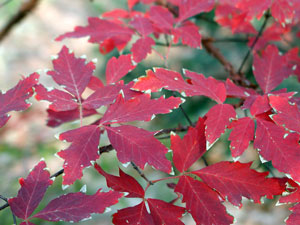Resource Library
Plant of the Week: Paperbark Maple
The University of Arkansas System Division of Agriculture does not promote, support or recommend plants featured in "Plant of the Week." Please consult your local Extension office for plants suitable for your region.
Plant of the Week
Paperbark Maple
Latin: Acer griseum

On the path leading to my small greenhouse grows one of my favorite trees, a paperbark maple (Acer griseum). The tree grows in the shade of a large post oak, so it is not as grand or large as I would prefer, but what it makes up in size it more than provides in interest throughout the year.
Acer griseum is a small- to medium-sized deciduous tree growing to 40 feet tall with an oval crown. When the tree is six or so years old, its bark begins peeling away in cinnamon-colored plates, giving rise to its common name. This cinnamon-colored peeling bark is unique to only this species among all the maples, so the tree is easy to identify. As the tree ages, it continues to maintain this colorful peeling bark, even on the main part of the trunk.
Paperbark maple has trifoliate leaves with leaflets 2 to 3 inches long and cut with three elongated pairs of lobes down the length of the leaf. The orange to maroon fall color is late in the season and very dependable, even in shady spots. The leaves and small branches are clothed in a downy gray pubescence. The species epitaph - griseum - means ‘gray,’ and refers to these hairs.
In Maples of the World (copyright 1994, Timber Press, Portland, Ore.), the authors describe this as one of the five best ornamentals in the world. For ranking so highly among the maple clan, it is still a relatively uncommon tree. Herein lies a tale.
Paperbark maple was, at the close of the 19th century, widely distributed in central China but nowhere abundant in the woodlands. Today, because of habitat loss, its range is much reduced. It was introduced into cultivation in 1901 by E.H. “China” Wilson when he made his first collecting trip for Veitch Nursery in England. When he was hired by the Arnold Arboretum in Boston in 1907, he brought two paperbark maple trees with him. Some say these two trees and the seedlings they produced are the source of all paperbark maples in the United States.
If the source of our paperbark maples was just these two trees, then we do indeed have a very narrow genetic base for all our paperbark maples. One of the characteristics of a narrow genetic base is inbreeding depression, which often manifests itself in low fertility and slow growth, hallmark characteristics of this species. But this is changing, thanks to new collecting efforts being made since 1990 by a consortium of botanical gardens that joined forces to form the North American China Plant Exploration Consortium, or NACPEC.
The group, working closely with Chinese botanical gardens and forestry universities, has made an annual trip since 1991 to various parts of the nation, where targeted collections take place. In 1994, the team visited what they dubbed “horticultural heaven” - a forested mountain retreat in the Wudang Mountains of the Hubei Province that has been protected from deforestation because of a famous Taoist temple. There they found a large stand of paperbark maples growing.
They collected seed and dug a few small seedlings growing on the forest floor. The seed never germinated, but 13 of the seedlings made it back to NACPEC institutions. One of these was an extremely vigorous seedling that is now growing twice as fast as all its brethren. The tree grew to 30 feet tall in just 15 years, and it may one day reach the 80-foot mark that trees reach in their native range. Hopefully, in years to come, these new trees will have sufficiently broadened the genetic base of the paperbark maple to make it a more useful tree in American gardens.
Paperbark maples are difficult to propagate but not especially difficult to grow. They are hardy from zones 5 through 8, doing best in cooler positions in the landscape. Plant them in a good soil in light shade where they can be used as a specimen tree. They have considerable drought tolerance, but marginal leaf burn may occur in hot, dry weather. Patience is the main ingredient required to successfully grow this beauty, for they are slow. My 15-year-old tree is 12 feet tall with a trunk about the size of my forearm.
By: Gerald Klingaman, retired
Extension Horticulturist - Ornamentals
Extension News - November 19, 2010
The University of Arkansas System Division of Agriculture does not maintain lists of retail outlets where these plants can be purchased. Please check your local nursery or other retail outlets to ask about the availability of these plants for your growing area.